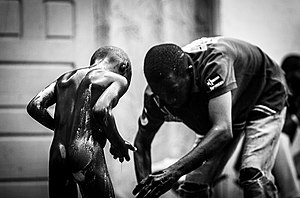Hygiene

Hygiene is the act of being clean. Washing the body to remove dirt and germs, brushing the teeth to keep them clean, shaving, using the toilet properly, and dressing correctly are some examples. Proper hygiene is often taught to children at a young age, and it becomes a habit. People who do not have good hygiene might smell bad, lose teeth, or become ill (sick).[1]
First proven use of the word in English was in 1677s. The word hygiene comes from the French word hygiène, which is the western version of Greek word ὑγιεινή (τέχνη) - hugieinē technē, meaning "(art) of health", from ὑγιεινός (hugieinos), "good for the health, healthy", [2] in turn from ὑγιής (hugiēs), "healthful, sound, salutary, wholesome". In ancient Greek religion, Hygeia (Ὑγίεια) was the daughter of Asclepius and represented health.
Hygiene Media
A tippy tap for handwashing after using a urine-diverting dry toilet in Pumpuentsa, Ecuador
A clear plastic toiletry bag
Solar water disinfection (SODIS) application in Indonesia using clear polyethylene terephthalate (PET) plastic beverage bottles
Codex Magliabechiano from the Loubat collection, 1904
Roman public baths (Thermae) in Bath, England
Related pages
References
- ↑ "Instrukcja mycia rąk - oświata, handel, zakłady i instytucje". Archived from the original on 2015-04-14. Retrieved 2013-04-11.
- ↑ "Henry George Liddell, Robert Scott, A Greek-English Lexicon, ὑγι-εινός". www.perseus.tufts.edu.
